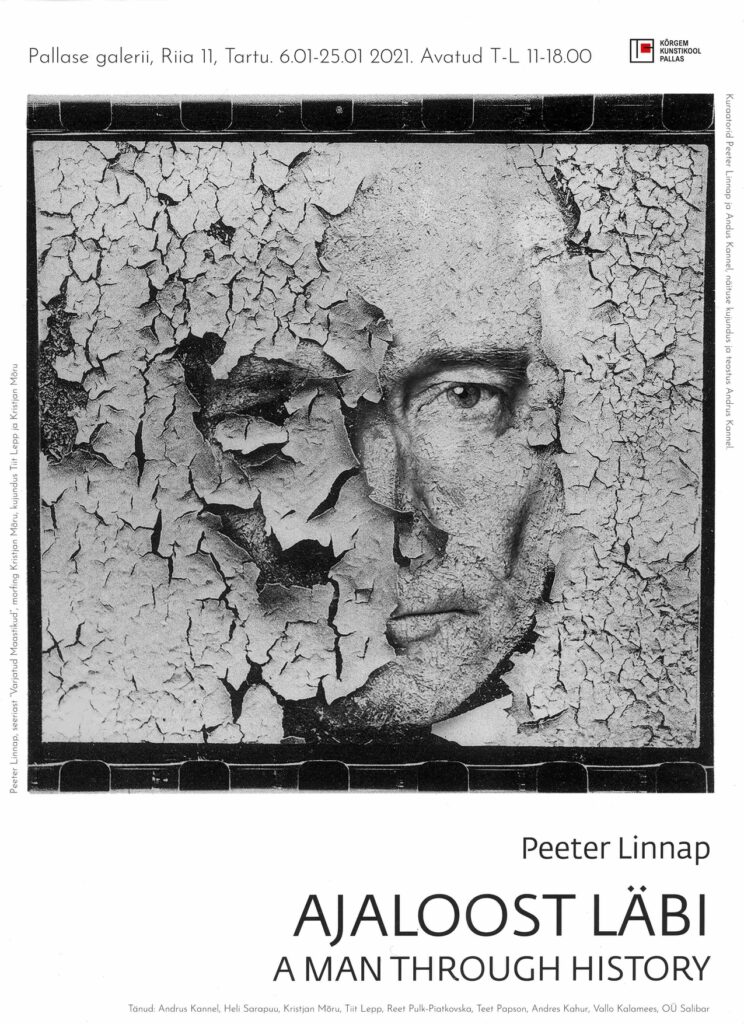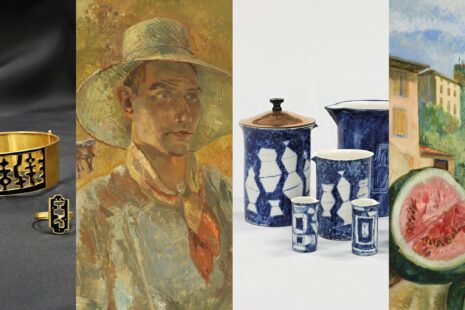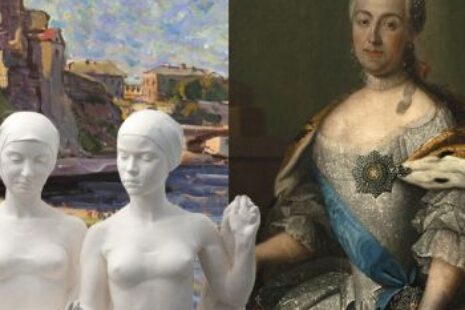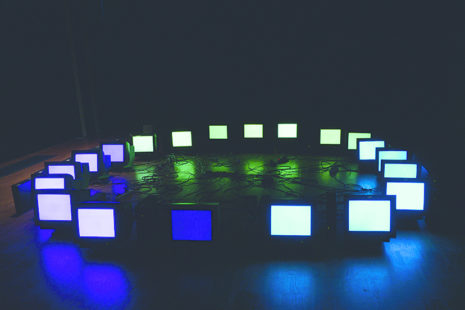As an artist, Peeter Linnap has produced mostly historical and political installations combining text and communication processes and the elements of photography, sculpture, performance etc. (“Concealed Landscapes”, “Summer 1955” 1993, “Le Top 50”, 1994, “Kleine Geschichte Estlands” and “Kalevipoeg: De facto”), both 1996, “AfterMonuments”, 1999 and “Homo EKAdemicus”, 2000).
Peeter Linnap’s art raises important questions about the breakdown of social values and human ideals. Although most of his works have been made in the form of photographs, image-sequences, tableaux vivants etc., there are in fact also elements of sculpture, painting or monuments. And there is always strong social commitment in his pieces. The current selection of his “Concealed Landscapes” (1990) comprises six photographs taken by Linnap at an abandoned Soviet rocket base. The photos bespeak a dismal ruination; crumbling walls with posters and other tattered images indicate a culture that has passed away, and not happily. “Summer 1955” (1993) is a series of snapshots printed by Linnap from a hitherto undeveloped roll of film shot in 1955. They show Estonian students at Tallinn University who have been conscripted into the Soviet army and are in uniform, pointing their weapons about in the landscape. Here forced into a war-game played to a degree against their own people, some of the men, according to the artist, later became prominent academics.
The emphasis shifts in another series, “AfterMonuments” (1999). In 15 color prints, Linnap himself poses on the base of a destroyed Soviet monument. His comedic gestures vary from ruthless caricatures of the heroic tradition to hilariously undignified moments, as when he clambers onto the monument. As “Concealed Landscapes” show the residual Soviet presence, and “Summer 1995” suggests the degree to which it intruded into the Estonian psyche, “After Monuments” aggressively mocks the absent statue as if to clean out the troubled accumulations in the national consciousness.
The series “Stone-Watcher” (1992) goes a step further. Linnap’s face is presented in five prints, four of which show his eyes covered with labels proclaiming the names of famous Western photographers (William Henry Fox Talbot, Man Ray, Harry Callahan and Jerry Uelsmann). The fifth portrait shows only Linnap’s face, with the eyes contemplatively shut. Here Linnap actively inserts himself into the Western artistic tradition at the interface between the histories of photography and conceptual art, completing the process of decolonization that is the aim of his critical and curatorial endeavors as well.
In his later work “Homo EKAdemicus”, Linnap ironically discusses the surprising continuation of the Soviet manners of photographic retouching in the present (!) Era through enlarged images of the Biographical Lexicon of Estonian Artists. This indicates changes the differences between the chronological time and mental perception of time. The situation is paradoxical – the calcareous manner of the portrait retouch of the repressive era turns de facto otherwise mild-lyrical artists and art historians into Stalinist robots first in the pictures and then, surprisingly, in real life as well. For example, visitors of the Arnolfini Gallery in Bristol U.K. considered these portraits to be representatives of the dead generations.
Peeter Linnap’s activities are philosophically based on Nietzsche-Foucault-Derrida’s deconstructivist ideology and critical art of the Anglo-American tradition with its central representatives like Victor Burgin, Allan Sekula, Martin Parr, Alfredo Jaar, Christian Boltanski, Karen Knorr ao.
Linnap gained his first knowledge of photography from his early mentor, filmmaker and photographer Peeter Tooming. The basis for his very productive application of Yuri Lotman’s concept of the semiosphere in visual research was laid with the help of prof. dr. Peeter Torop and Linnap’s studies at the Tartu University Department of Semiotics that Peeter Linnap (b. 1960) graduated with Ph.D. in 2006. publishing his first major theory book “Photology”. “Photology” was followed by Linnap’s next exhaustive research volumes like “History of Estonian Photography 1839-2015” (2016) and “Anthology of Estonian Photography” I-V (2020 – approx. 2025), as well as his chapters for “The History of European Photography 1900-2000” I-III compiled by Vaclav Macek and the chapters of national photography in the History of Estonian Art, Vol V (ed by Prof. Dr. K. Kodres, and Prof. Dr. M. Kalm) and Vol VI, Part II (edited by Prof. Dr. K. Kodres, compiled by Prof. Dr. Emeritus J. Kangilaski). Linnap has written state-of-the-art research papers for high end academic journals of “Springer” (U.S) and “Intellect” (U.K and U.S) publishers, also for encyclopedias (ENE, EE, TEA, etc.). His artworks and academic research have been featured in world-class art magazines, including “Art in America” (New York), “Art & Design” (London), “European Photography” (Berlin), etc. as well as important reference works such as the “Oxford Encyclopedia of Aesthetics”. “Who is Who in Research: Visual Culture” and others. Linnap, who has authored in total 13 books and compiled 7 volumes, is also known as one of the pioneers and central figures of Estonian contemporary art. He was one of the central figures in establishing university level education in the field of photography, the initiator and chief curator of the legendary Saaremaa Biennials with Anti Kuus and Eve Linnap (later Kiiler). Thanks to Linnap the artworks of nearly 70 internationally relevant artists have been exhibited in Estonia and some 50 theorists from all over the world have been giving lectures here. Linnap currently works as a professor and head of photography at Pallas University of Applied Sciences. He has taught and supervised around 200 young artists.
Thanks for support and cooperation: Thomas McEvilley, Mary Ann Lynch, Jack Lynch, Jan-Erik Lundström, John Stathatos, Inka Schube, Friedman Hoerner, Peeter Laurits, Reet Varblane, Johannes Saar, Rainer Vilumaa, Andrus Kannel, Vallo Kalamees, Andres Kahur, Vallo Nuust, Mare Muuga, Reet Pulk-Piatkowska, Teet Papson, Salibar OÜ, Uuno Kasemets, Laura Linnap, Linda Linnap, Mattias Linnap, Uku Linnap, Paul Robert Linnap, Theodor Peeter Linnap, Kristjan Mõru, Faculty of Taste, Mobil gallery, Tiit Lepp, Aivar Täpsi, printing house Bookmill, Pallas University of Applied Sciences, Estonian Cultural Endowment.
For more information:
peeter@linnap.com
andrus.kannel@gmail.com
reet.pulk-piatkowska@pallasart.ee
See also https://www.etis.ee/CV/Peeter_Linnap/est https://en.wikipedia.org/wiki/Peeter_Linnap https://www.efis.ee/et/inimesed/id/1594/biograafia https://digikogu.ekm.ee/ekm/authors/author_id-183 https://arhiiv.err.ee/seeria/ajaloo-vabrik/kultuur/31 https://arhiiv.err.ee/seeria/invasioon/kultuur/31
Gallery name: Gallery Pallas
Address: Riia 11, Tartu
Opening hours: Tue, Thu-Sat 11:00 - 18:00, Wed 10:00 - 18:00
Open: 07.01.2021 - 20.02.2021







